These are certainly noble goals, but there is one more that seems to stand out in the minds of the English, that they may speak of less, but which they think of more. It is not enough for art to be suggestive, didactic, moral, or popular; it must also be national. It must be English. Except for some rare exceptions, all great British artists are clearly opposed to foreign (i.e. French) influence: Watts, Hunt, Burne-Jones and his entire school, Strudwick, Holiday, Stillman, Rooke, Walter Crane, Spencer-Stanhope, Spence… it is quite obvious. In Alma-Tadema this is less visible, although we should not forget the originality of his compositions, and that a part of his training took place at Baron Wappers’ school in Antwerp. Leighton, who studied just about everywhere, studied less in France than in Italy and Germany, and Herkomer did not study there at all. Finally, Millais, who resembled a Frenchman when compared with his colleagues, distances himself so much from them by his colours that one could pick out his paintings among thousands of others. Their critics demand above all that they remain English. Phillips says of Walker “…he had that special quality which can never be too highly praised: despite his innovations he remained national in feeling and character.” He adds that though this innovator’s art had its faults, “the simple fact that it was born of the English soil and national in terms of colour made it successful.” Harry Quilter says of Poynter that “…he was educated in an insular fashion, and had very little sympathy for modern art. What the French call the grands contours du dessin are totally lacking in his work.” Mrs Barrington, praising Millais, informs us that “his feeling is invariably pure, transparent, and deeply wholesome. Fortunately, these qualities contrast with the crude scarecrows and disagreeable suggestions so prominent in the art patronised by the French.” And to ensure that we know exactly what this French taste is, she warns us elsewhere that it is, “in terms of sentiment, a search for mediocrity.” When addressing his students, Ruskin said of the Greeks that they were “to be looked at sometimes. Not continually, and never as a model for imitation. For you are not Greeks; but, for better or worse, English creatures; and cannot do, even if it were a thousand times better worth doing, anything well, except what your English hearts shall prompt and your English skies teach you.” At the opposite pole of aesthetics, Millais said: “There is among us a band of young men who, though English, insist on painting with a broken French accent, all of them much alike, and seemingly content to lose their identity in the imitation of French masters, whom they are constitutionally, absolutely, and in the nature of things, unable to copy with justice either to themselves or their models.”[45] And none of them doubted that the hearts and skies of England could inspire art superior to that of any other period and country. “That sketch of four cherub heads from an English girl, by Sir Joshua Reynolds, at Kensington, is an incomparably finer thing than ever the Greeks did,” says Ruskin.
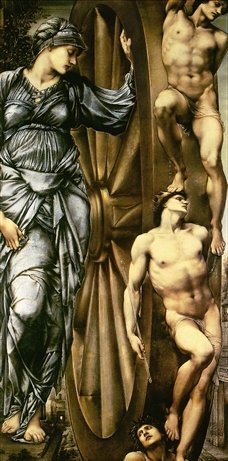
Edward Burne-Jones,
The Wheel of Fortune, 1875-1883.
Oil on canvas, 200 x 100 cm.
Musée d’Orsay, Paris.
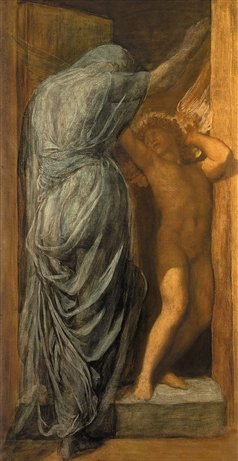
George Frederick Watts,
Love and Death, 1862.
Oil on panel, 152.4 x 50.8 cm.
Private Collection.
And Millais adds: “Place an outstanding Rembrandt, an outstanding Reynolds, and an outstanding contemporary work side by side; judge them taking into account the difference due to ageing, and you will find that there are few reasons to complain of the decline of art. On the contrary, you will be proud of our art of today.”[46] They draw their hopes from quite unexpected comparisons, and in The Two Paths, there is a comment from Ruskin that is worth an entire book of aesthetics: “The dominion of the seas seems to have been associated, in past time, with dominion in the arts also: Athens had them together; Venice had them together; but by so much as our authority over the ocean is wider than theirs over the Aegean or the Adriatic, let us strive to make our art more widely beneficent than theirs, though it cannot be more exalted; so working out the fulfilment, in their wakening as well as their warning sense, of those great words of the aged Tintoret: Sempre si fa il Mare maggiore.”[47]
Seen in this way, in its entirety, contemporary English art was born of a great effort, a tremendous obstinate aspiration toward the noble, philosophical, and national. It did not appear spontaneously, as it did in some countries, from the joy of admiring and seeing, from the happiness of forgetting, through the splendid forms of nature and the beings that fill it, the indifference of this nature, the baseness of these beings, and even the torment of our own thoughts. It was a labour of duty, not a labour of love.[48] It came into this world either to ennoble life, or to teach about life, or to improve life. It did not come to live its own life, free and joyous, to develop without moral or philosophical teachers, with all the vitality and opulence of the vines of southern France. It tried to achieve all goals except that of being itself, as we imagine that God is: for nothing, for the sole pleasure of being. Thus, English art is related to everything: to science through its details, to psychology through its poses, to patriotism through its autonomy. It is only beauty itself to which it is not necessarily connected, and to which it does not necessarily seek to be connected. It reaches its roots deep, very deep into the soil from which it was born. It emerged from national life and dreams, or at least from their most solemn and contemplative elements. It found its inspiration in the ideas, feelings and prejudices of the most intellectual class in England. Tearing up any painting from the National Gallery would be like tearing up an English flag! Its masters were autonomous, were unreluctantly and dauntlessly Anglo-Saxon or British, and if it were true that a great people expressing themselves necessarily produce great art, English art would be the greatest in the contemporary world.
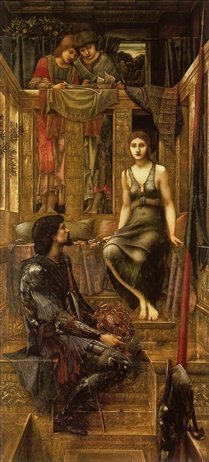
Edward Burne-Jones, King Cophetua
and the Beggar Maid, 1880-1884.
Oil on canvas, 293.4 x 135.9 cm.
Tate Britain, London.
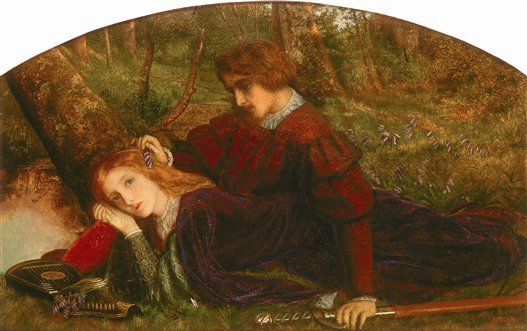
Arthur Hughes,
The Brave Geraint, c. 1860.
Oil on canvas, 23 x 36 cm.
Lady Anne Tennant Collection.
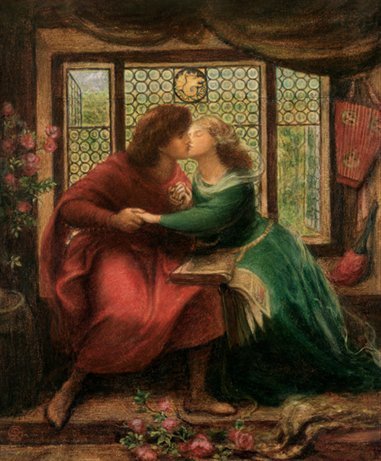
Dante Gabriel Rossetti,
Paolo and Francesca, c. 1867.
Watercolour on paper, 43.7 x 36.1 cm.
National Gallery of Victoria, Melbourne.
Now, should this great effort be despised or should it be imitated? Neither one nor the other. When we consider the careers of men like Watts, Hunt, and Burne-Jones, we regret that great painting is not necessarily the reward for magnificent ideas, and that harmony of colour flows from other sources than the dignity of lives. Regrettably, we find proof here that intellectual and moral culture, a deep understanding of the subject, unremitting manual work, and a sense of the high purpose of art are not sufficient to produce good painting, and it was the English who demonstrated this fact. One is troubled to find that the people with the most particular point of view and the most national bearing, the people who played the most inimitable role in this world, expressed itself in vain through the fine arts: if it did not yet have the sensitive eye of a colourist and the confident hand of an illustrator, it might have produced interesting works, but never beautiful ones. When looking at these paintings, in which the suggestive side of the subject is better grasped and the plastic side more poorly grasped than perhaps anywhere else, one is troubled to see that certain theories, though upheld by the most eminent minds and applied by the most meticulous hands, have been refuted by the facts. But, we salute this mistake as the noblest one that has ever been made. We count these errors among those that bring more honour to humanity than many successes do, and one imagines that perhaps, in the immaterial order of things where nothing is lost, they will give the nation that saw them emerge a right to success in the future. As for imitating them, this would be even worse than ignoring them. It is not that the English do not possess precisely some of the qualities that are lacking in other painters, such as the in-depth study and serious development of a subject and the persistent search for novel poses. If we could do in aesthetics what can be done so well now in agriculture – restore the precise life-giving element that is lacking in the soil – we could learn a lesson from their example and be supported by it. But crude imitation that amounts to a pastiche of the form given to an artist’s figures, copying their features, the equilibrium of their poses, and the devices of composition, is always at fault, whether the model to be imitated is Raphael or da Vinci. The only intelligent imitation consists of seeking inspiration in the guiding ideas of an art and not its works, observing its rules and not its examples, drawing on its sources and not its products. The Pre-Raphaelite idea is that one must be oneself; by copying any Pre-Raphaelite forms whatsoever, we become someone else.